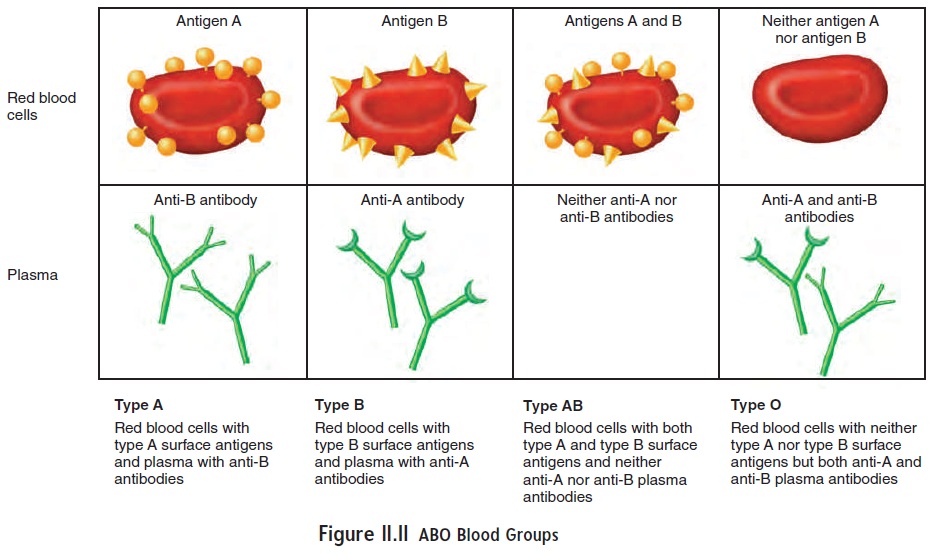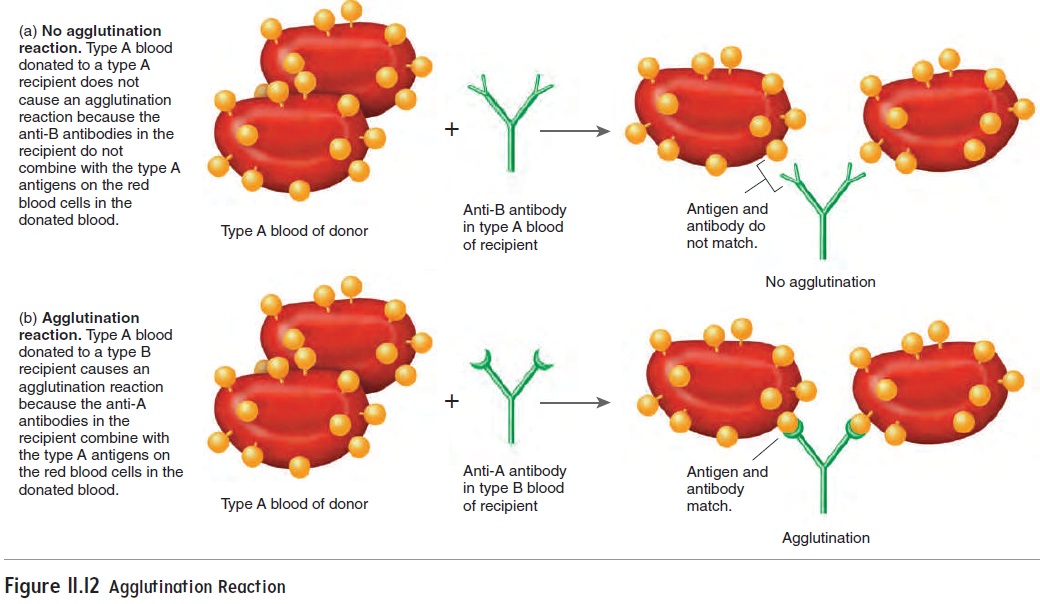Chapter: Essentials of Anatomy and Physiology: Blood
ABO Blood Group

ABO Blood Group
The ABO blood group system is used to categorize human blood. In this blood group system, there are two types of antigens that may appear on the surface of the red blood cells, type A antigen and type B antigen. Type A blood has type A antigens, type B blood has type B antigens, and type AB blood has both types of antigens. Type O blood has neither A nor B antigens (figure 11.11). Antibodies against the antigens are usually present in the plasma of blood. Plasma from type A blood contains anti-B antibodies, which act against type B antigens; plasma from type B blood contains anti-A antibodies, which act against type A antigens. Type AB blood plasma has neither type of antibody, and type O blood plasma has both anti-A and anti-B antibodies.

The ABO blood types do not exist in equal numbers. In caucasians in the United States, the distribution is type O, 47%; type A, 41%; type B, 9%; and type AB, 3%. Among African-Americans, the distribution is type O, 46%; type A, 27%; type B, 20%; and type AB, 7%.
Normally, antibodies do not develop against an antigen unless the body is exposed to that antigen; however, the anti-A and/or anti-B antibodies are present in the blood even without exposure to antigens on foreign red blood cells. One possible explanation for the production of anti-A and/or anti-B antibodies is that type A or B antigens on bacteria or food in the digestive tract stimulate the formation of antibodies against antigens that are different from the body’s own antigens. In support of this explanation, anti-A and anti-B antibodies are not found in the blood until about 2 months after birth. It is possible that an infant with type A blood would produce anti-B antibodies against the B antigens on bacteria or food. Meanwhile, an infant with A antigens would not produce antibodies against the A antigens on bacteria or food because mechanisms exist in the body to prevent the production of antibod-ies that would react with the body’s own antigens .
When a blood transfusion is performed, the donor is the per-son who gives blood, and the recipient is the person who receives it. Usually, a recipient can successfully receive blood from a donor as long as they both have the same blood type. For example, a per-son with type A blood can receive blood from a person with type A blood. No ABO transfusion reaction occurs because the recipient has no anti-A antibodies against the type A antigen. On the other hand, if type A blood were donated to a person with type B blood, a transfusion reaction would occur because the person with type B blood has anti-A antibodies against the type A antigen, causing agglutination (figure 11.12).

Historically, people with type O blood have been called uni-versal donors because they can usually give blood to the other ABO blood types without causing an ABO transfusion reaction. Their red
However, the term universal donor is misleading. Transfusion of type O blood can still produce a transfusion reaction in one of two ways: First, mismatching blood groups other than the ABO blood group can cause a transfusion reaction. To reduce the likelihoodof a transfusion reaction, all the blood groups must be correctly matched (see “Type and Crossmatch” in the next section). Second, antibodies in the donor’s blood can react with antigens on the recipient’s red blood cells. For example, type O blood has anti-A and anti-B antibodies. If type O blood is trans-fused into a person with type A blood, the anti-A antibodies (in the type O donor blood) react against the A antigens (on the red blood cells in the type A recipient blood). Usually, such reactions are not serious because the antibodies in the donor’s blood are diluted in the large volume of the recipient’s blood. Even though such transfusion reactions seldom occur, type O blood is given to a person with another blood type only in life-or-death situations
Related Topics